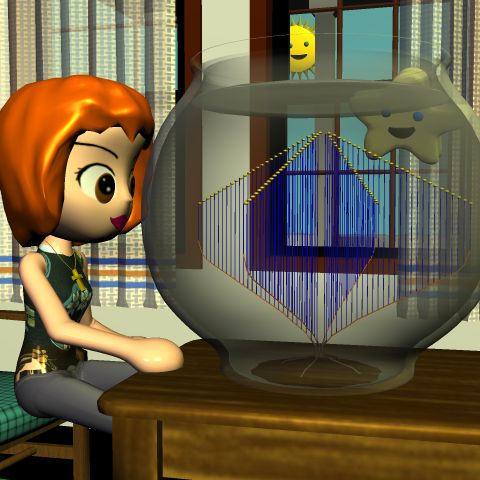Saturday, November 10, 2012
Life imitates art
A fantastic new type of primitive animal has been found at the bottom of the sea, which raises a number of design questions. Good pictures here, official abstract here.
Only a few of these sponges (Chondrocladia lyra) have been spotted and brought in by robotic submarines. Their behavior and functions are only partly understood. Apparently the pads at the top of each stem are sperm carriers; eggs form in temporary nodes along the vertical shafts. Apparently the critter feeds by trapping little shrimp and other plankton in Velcro-like hairs along the vertical stems. The shrimp is dissolved, and the nutrition passes into the vertical stem and gets distributed through the entire animal.
 Three design questions:
(1) How do the stems grow perfectly vertical and equally spaced? Is there a gravity sensor as in plant roots? If so, how does it compensate for ocean currents?
(2) How and why do the stem lengths form a 'musical' series? Does each stem pick up a different frequency, corresponding to the motions of a different type of plankton? Do they have different enzymes to digest their own preferred shrimp?
(3) How do the main sections form nearly perfect angles? Apparently there isn't a single symmetry standard; some specimens have two harps, some have four (as I've modeled), some have six. Each pattern is nicely regular.
This discovery breaks down one old and basic rule. Until now, we thought Nature refused to make straight lines, and strongly refused to make parallel equally spaced straight lines. If you saw such a pattern, you could be sure it was a human artifact. Now we can't be sure!
Three design questions:
(1) How do the stems grow perfectly vertical and equally spaced? Is there a gravity sensor as in plant roots? If so, how does it compensate for ocean currents?
(2) How and why do the stem lengths form a 'musical' series? Does each stem pick up a different frequency, corresponding to the motions of a different type of plankton? Do they have different enzymes to digest their own preferred shrimp?
(3) How do the main sections form nearly perfect angles? Apparently there isn't a single symmetry standard; some specimens have two harps, some have four (as I've modeled), some have six. Each pattern is nicely regular.
This discovery breaks down one old and basic rule. Until now, we thought Nature refused to make straight lines, and strongly refused to make parallel equally spaced straight lines. If you saw such a pattern, you could be sure it was a human artifact. Now we can't be sure!
 Three design questions:
(1) How do the stems grow perfectly vertical and equally spaced? Is there a gravity sensor as in plant roots? If so, how does it compensate for ocean currents?
(2) How and why do the stem lengths form a 'musical' series? Does each stem pick up a different frequency, corresponding to the motions of a different type of plankton? Do they have different enzymes to digest their own preferred shrimp?
(3) How do the main sections form nearly perfect angles? Apparently there isn't a single symmetry standard; some specimens have two harps, some have four (as I've modeled), some have six. Each pattern is nicely regular.
This discovery breaks down one old and basic rule. Until now, we thought Nature refused to make straight lines, and strongly refused to make parallel equally spaced straight lines. If you saw such a pattern, you could be sure it was a human artifact. Now we can't be sure!
Three design questions:
(1) How do the stems grow perfectly vertical and equally spaced? Is there a gravity sensor as in plant roots? If so, how does it compensate for ocean currents?
(2) How and why do the stem lengths form a 'musical' series? Does each stem pick up a different frequency, corresponding to the motions of a different type of plankton? Do they have different enzymes to digest their own preferred shrimp?
(3) How do the main sections form nearly perfect angles? Apparently there isn't a single symmetry standard; some specimens have two harps, some have four (as I've modeled), some have six. Each pattern is nicely regular.
This discovery breaks down one old and basic rule. Until now, we thought Nature refused to make straight lines, and strongly refused to make parallel equally spaced straight lines. If you saw such a pattern, you could be sure it was a human artifact. Now we can't be sure!
Labels: Grand Blueprint, Smarty-plants
